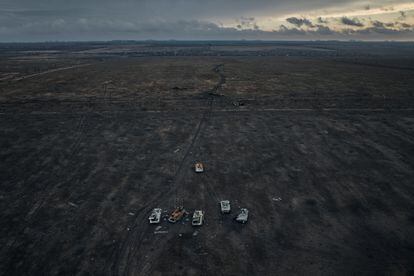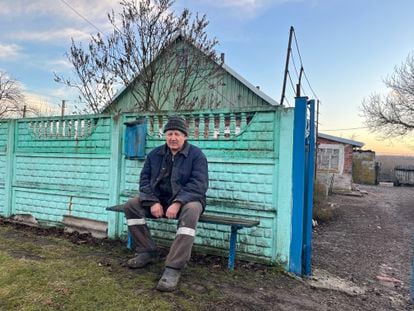The apocalyptic image shows a field full of weeds and filled with motionless bodies in green military uniforms. “They're Russian, look at them,” Stella murmurs. Some of those bodies get up after a few minutes. Mostly, no. “Later, others will arrive and then more, like sleepwalkers. We see it every day,” says the soldier from an aerial reconnaissance unit on the Avdiivka front, in the province of Donetsk, the focus of the fiercest fighting of Russia's war against Ukraine. The Kremlin forces have been attacking the industrial city of Avdiivka for weeks, in waves, like zombies, an anthill of tunnels, factories, bunkers and trenches shored up during the war in the eastern region of Donbas in 2014. Russia punishes it with bombings. constants and that siege of troops zombie, as he did before in Bakhmut. Avdiivka today is a mass of rubble, sinkholes and buildings sewn together by projectiles. Another frozen hell.
“It seems they are back at it,” spits Aleksandr, sergeant of the 47th separate mechanized brigade. The burly soldier advances through the viscous and sticky mud of Donbas towards one of his group's positions, a few kilometers from the besieged mining town, where an American Paladin howitzer operates. They have been stationed on the Avdiivka front for months, sinking in that mud. They resist the attacks of Moscow's troops, which are trying to pocket the city from the flanks to avoid the street fighting that they faced in Bakhmut. The sergeant lights a cigarette. He strains his ears. “That [disparo] It has been from the beginning,” he comments. The bombings sound close, but he doesn't even blink.
The 47th brigade, like many others, is on an ammunition diet. Their arsenals are depleted. They fight with what they have available, not always with what is best suited to achieving the objective, Aleksandr acknowledges, shrugging his shoulders. kyiv aspires to receive more missiles from its Western allies. The EU promised Ukraine one million artillery rounds, but has only managed to supply less than half of that and is still struggling to increase its industrial capacity to meet that commitment. This past Thursday, the United States announced another shipment — which may be the last for some time due to the Republican blockade — with several types of air defense ammunition, for high mobility and anti-armor artillery.
Meanwhile, Russia has focused its war economy on the invasion effort. Western sanctions and market isolation have not prevented the Kremlin from dedicating most of its productive capacity to weapons. They make missiles in bread factories, they assemble ammunition in tractor industries. They try at all costs to replenish themselves. Russian President Vladimir Putin has not put aside his objectives of subduing Ukraine. His main war effort is now focused on capturing the entire Donbas region.

Join EL PAÍS to follow all the news and read without limits.
Subscribe
Ukrainian weapons, some of them supplied by its Western allies, are overstretched at many points on the battlefront. Also in Avdiivka. “Russia does not have better weapons, but it does have more material. And their strategy is to launch everything,” explains Yevgeni, one of the soldiers of the 47th, established with weapons such as the American-made M-2 Bradley and Leopard 2 tanks, supplied by NATO allied countries. The Kremlin is firing artillery and drones of various types and is using frontal assaults, feigned attacks and smoke to hide the attacks and is closely monitoring all roads towards Avdiivka, where along with regular Russian troops, convicts recruited to go to the front and contractors various, a unit composed of former mercenaries of the Wagner group is fighting, as reported by Russian military bloggers.
In recent weeks, it has also been releasing a rain of mines that expand and leave roads and fields impassable. Also for the few civilians left in an area of eastern Ukraine that Putin said he wanted to liberate, and that is bearing one of the worst parts of this large-scale war that is on its way to entering its third year and that he carries on his back. the consequences of that of the Donbas separatists. For the tough people of the mining lands of eastern Ukraine, every day for a decade has been a new episode of an infinite war.
Putin covets Avdiivka, once one of the hearts of Donbas, as his next piece. He already wanted to control it in the 2014 war, through his sponsored pro-Russian separatists. He didn't make it. Since then, the mining town, which had 32,000 inhabitants before the invasion, had become one of Ukraine's reinforced military strongholds. However, at immense human and material cost, Russia has managed to advance positions to surround it. A little further south, after a brutal siege, Moscow has taken control of the ruins of Marinka. Because of what was a large-scale city of 10,000 inhabitants before the war, with its schools, parks, shops, only charred rubble remains.
With its brutal operations, the Kremlin has managed to take more territory than it has lost in 2023, according to a report from the Estonian Ministry of Defense. However, none of those ruined enclaves conquered in the east and south represent a turning point that will turn the balance in the line of the battle front of more than 1,300 kilometers that, after the expected Ukrainian counteroffensive was derailed, has barely changed significantly this year.

Ukraine works on the Avdiivka front launching artillery attacks to stop the Russian advance and protect the movement of its assault groups. Andrei, a soldier who is almost two meters tall and short on words, has
just recovered from a wound suffered in one of those assaults. He operates a heavy Soviet-made machine gun and was hit by Russian fire a month ago. He says that he still has a piece of shrapnel in his back. “He stays there, for the memory,” he says, shrugging his shoulders. After taking Marinka, the Russian assault on Avdiivka has slowed down a bit. On New Year's Eve, Ukrainian President Volodymyr Zelensky visited the entrance to the city and some of its bunkers to decorate the military personnel stationed there. Meanwhile, Russia has increased the number of reserves in the area, according to Oleksandr Shtupun, spokesman for the Ukrainian General Staff.
Russian forces have been pushing for weeks to advance towards a coke mining plant, which was once one of the largest in Europe and which today is another of those apocalyptic landscapes. “The situation is difficult and we try to joke about everything and about this,” says Sergeant Aleksandr. “Seeing how they move towards the plant, we make the joke that they are going to see how the coke is snorted. “They don't know what kind of coke they're looking for, they go there like drug addicts,” the soldier jokes.
Russia's war against Ukraine has become a battle of attrition, of positions, where Kremlin troops try to capture small pieces of land regardless of the human cost. The UK intelligence agency also claims that Russia is suffering the highest number of casualties so far in the war, especially due to the bloody battle for Avdiivka. The British Ministry of Defense indicates that the daily number of Russian casualties in Ukraine has increased by almost 300 during the course of 2023 and that if it continues at this rate it will have lost more than half a million troops by the end of 2024. US intelligence assures, Furthermore, Russia executes soldiers who retreat on the Avdiivka front.
Ukrainian troops have also suffered heavy losses. Neither kyiv nor Moscow report casualties. Last week, in an unusual press conference, the commander-in-chief of the Ukrainian Armed Forces, Valeri Zaluzhni, pointed out that for Russia the loss of life is not a variable to change strategy, and admitted that the case could come. that Ukrainian forces withdraw to positions outside Avdiivka. “We will defend as much as we can while we have the strength to do so. If the forces are not enough and we see that it is better to save people, then, of course, we will make that decision and save people,” he assured. He still weighs kyiv's strategy of holding Bakhmut for nine months of assault at a very high cost that also distracted forces in other positions.

Meanwhile, Russian troops advance towards Novoselivka Persha, a dozen kilometers from Avdiivka. They have already managed to take positions seven kilometers from the small town. Artillery thunders in a landscape already wounded since the war in Donbas. In a small square, in front of the House of Culture that Russia struck down a few weeks ago, the statue of a Soviet soldier who fell in the Second World War, which Russia calls the Great Patriotic War, stands almost intact. “Stupid bastards,” laments Anton Filipovich. The man, who served in the Soviet Army near the Baikonur Cosmodrome in Kazakhstan, looks through the fence of his house and sits on the bench at the entrance. He shakes his head: “I don't like all this. Putin is a real idiot. I don't understand why he attacks us. Does he perhaps not have enough land?
Follow all the international information on Facebook and xor in our weekly newsletter.
Subscribe to continue reading
Read without limits
_
#Russia #launches #39zombie39 #soldiers #Avdiivka #fiercest #trench #Donbas